第六章 套利定价理论(APT)
- 格式:ppt
- 大小:1.60 MB
- 文档页数:97
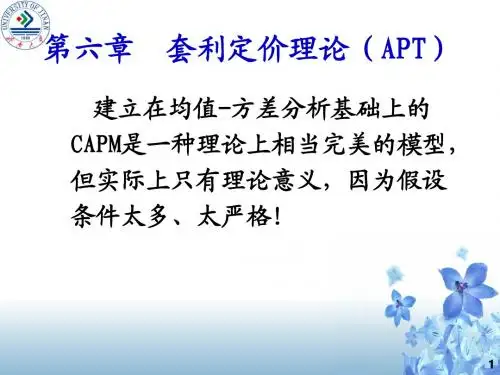
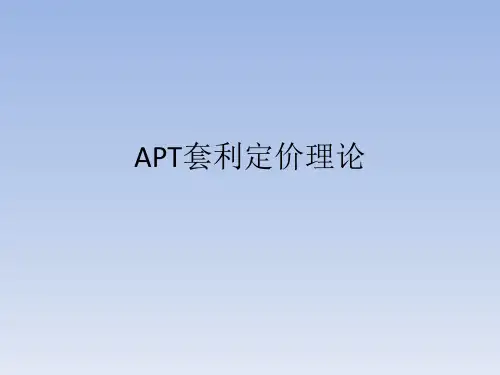
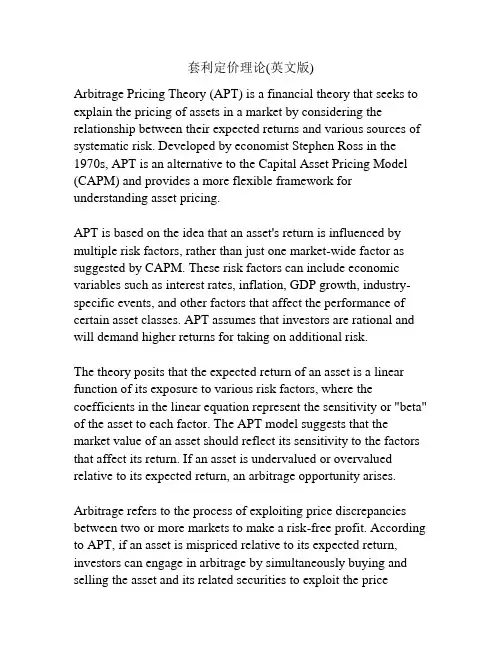
套利定价理论(英文版)Arbitrage Pricing Theory (APT) is a financial theory that seeks to explain the pricing of assets in a market by considering the relationship between their expected returns and various sources of systematic risk. Developed by economist Stephen Ross in the 1970s, APT is an alternative to the Capital Asset Pricing Model (CAPM) and provides a more flexible framework for understanding asset pricing.APT is based on the idea that an asset's return is influenced by multiple risk factors, rather than just one market-wide factor as suggested by CAPM. These risk factors can include economic variables such as interest rates, inflation, GDP growth, industry-specific events, and other factors that affect the performance of certain asset classes. APT assumes that investors are rational and will demand higher returns for taking on additional risk.The theory posits that the expected return of an asset is a linear function of its exposure to various risk factors, where the coefficients in the linear equation represent the sensitivity or "beta" of the asset to each factor. The APT model suggests that the market value of an asset should reflect its sensitivity to the factors that affect its return. If an asset is undervalued or overvalued relative to its expected return, an arbitrage opportunity arises. Arbitrage refers to the process of exploiting price discrepancies between two or more markets to make a risk-free profit. According to APT, if an asset is mispriced relative to its expected return, investors can engage in arbitrage by simultaneously buying and selling the asset and its related securities to exploit the pricedifference. This process of arbitrage will then push the asset's price towards its fair value by eliminating the mispricing.In practical terms, an arbitrageur would identify assets that are mispriced according to their expected returns and risk factors. They would then create a portfolio that is hedged against the systematic risks by taking long or short positions in the mispriced asset and its related securities. By constructing such a portfolio, the arbitrageur can eliminate the effects of systematic risk, thereby making a risk-free profit.APT provides a more realistic approach to asset pricing compared to the CAPM as it accounts for multiple risk factors and their impact on asset returns. It allows investors to identify mispriced assets and profit from them through arbitrage. By using this theory, market participants can enhance their investment strategies and potentially achieve higher returns by capitalizing on pricing discrepancies in various markets.APT的良好理论基础始于对市场有效性和资产定价的理解。
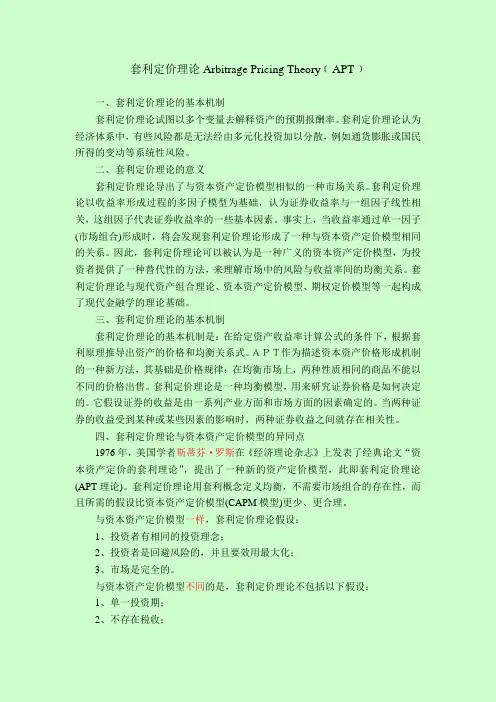
套利定价理论Arbitrage Pricing Theory﹝APT﹞一、套利定价理论的基本机制套利定价理论试图以多个变量去解释资产的预期报酬率。
套利定价理论认为经济体系中,有些风险都是无法经由多元化投资加以分散,例如通货膨胀或国民所得的变动等系统性风险。
二、套利定价理论的意义套利定价理论导出了与资本资产定价模型相似的一种市场关系。
套利定价理论以收益率形成过程的多因子模型为基础,认为证券收益率与一组因子线性相关,这组因子代表证券收益率的一些基本因素。
事实上,当收益率通过单一因子(市场组合)形成时,将会发现套利定价理论形成了一种与资本资产定价模型相同的关系。
因此,套利定价理论可以被认为是一种广义的资本资产定价模型,为投资者提供了一种替代性的方法,来理解市场中的风险与收益率间的均衡关系。
套利定价理论与现代资产组合理论、资本资产定价模型、期权定价模型等一起构成了现代金融学的理论基础。
三、套利定价理论的基本机制套利定价理论的基本机制是:在给定资产收益率计算公式的条件下,根据套利原理推导出资产的价格和均衡关系式。
APT作为描述资本资产价格形成机制的一种新方法,其基础是价格规律:在均衡市场上,两种性质相同的商品不能以不同的价格出售。
套利定价理论是一种均衡模型,用来研究证券价格是如何决定的。
它假设证券的收益是由一系列产业方面和市场方面的因素确定的。
当两种证券的收益受到某种或某些因素的影响时,两种证券收益之间就存在相关性。
四、套利定价理论与资本资产定价模型的异同点1976年,美国学者斯蒂芬·罗斯在《经济理论杂志》上发表了经典论文“资本资产定价的套利理论”,提出了一种新的资产定价模型,此即套利定价理论(APT理论)。
套利定价理论用套利概念定义均衡,不需要市场组合的存在性,而且所需的假设比资本资产定价模型(CAPM模型)更少、更合理。
与资本资产定价模型一样,套利定价理论假设:1、投资者有相同的投资理念;2、投资者是回避风险的,并且要效用最大化;3、市场是完全的。
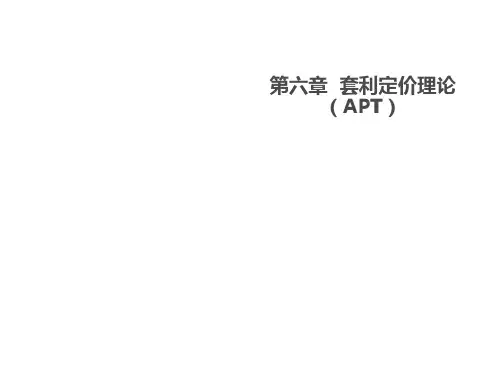
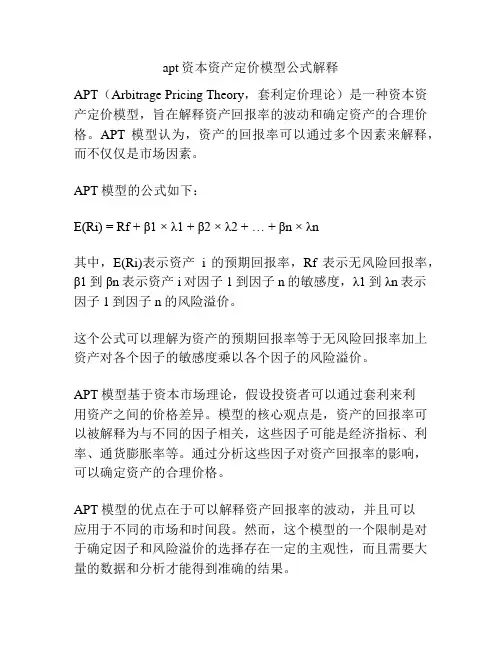
apt资本资产定价模型公式解释
APT(Arbitrage Pricing Theory,套利定价理论)是一种资本资产定价模型,旨在解释资产回报率的波动和确定资产的合理价格。
APT模型认为,资产的回报率可以通过多个因素来解释,而不仅仅是市场因素。
APT模型的公式如下:
E(Ri) = Rf + β1 × λ1 + β2 × λ2 + … + βn × λn
其中,E(Ri)表示资产i的预期回报率,Rf表示无风险回报率,β1到βn表示资产i对因子1到因子n的敏感度,λ1到λn表示因子1到因子n的风险溢价。
这个公式可以理解为资产的预期回报率等于无风险回报率加上资产对各个因子的敏感度乘以各个因子的风险溢价。
APT模型基于资本市场理论,假设投资者可以通过套利来利
用资产之间的价格差异。
模型的核心观点是,资产的回报率可以被解释为与不同的因子相关,这些因子可能是经济指标、利率、通货膨胀率等。
通过分析这些因子对资产回报率的影响,可以确定资产的合理价格。
APT模型的优点在于可以解释资产回报率的波动,并且可以
应用于不同的市场和时间段。
然而,这个模型的一个限制是对于确定因子和风险溢价的选择存在一定的主观性,而且需要大量的数据和分析才能得到准确的结果。

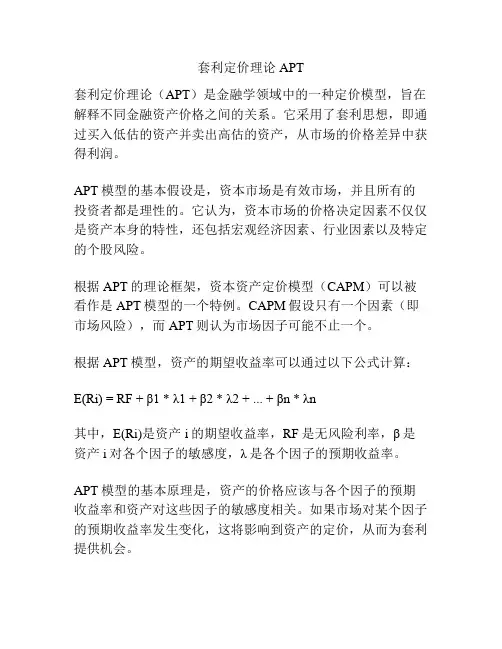
套利定价理论APT套利定价理论(APT)是金融学领域中的一种定价模型,旨在解释不同金融资产价格之间的关系。
它采用了套利思想,即通过买入低估的资产并卖出高估的资产,从市场的价格差异中获得利润。
APT模型的基本假设是,资本市场是有效市场,并且所有的投资者都是理性的。
它认为,资本市场的价格决定因素不仅仅是资产本身的特性,还包括宏观经济因素、行业因素以及特定的个股风险。
根据APT的理论框架,资本资产定价模型(CAPM)可以被看作是APT模型的一个特例。
CAPM假设只有一个因素(即市场风险),而APT则认为市场因子可能不止一个。
根据APT模型,资产的期望收益率可以通过以下公式计算:E(Ri) = RF + β1 * λ1 + β2 * λ2 + ... + βn * λn其中,E(Ri)是资产i的期望收益率,RF是无风险利率,β是资产i对各个因子的敏感度,λ是各个因子的预期收益率。
APT模型的基本原理是,资产的价格应该与各个因子的预期收益率和资产对这些因子的敏感度相关。
如果市场对某个因子的预期收益率发生变化,这将影响到资产的定价,从而为套利提供机会。
套利定价理论的重要性在于它提供了一种解释和预测资产价格变动的工具。
通过分析和估计各个因子的预期收益率和资产对这些因子的敏感度,投资者可以找到被低估或高估的资产,并利用市场的定价差异获得套利机会。
然而,APT模型也存在一些限制。
首先,它的有效性依赖于投资者对各个因子的预期收益率和资产对这些因子的敏感度的准确估计。
如果估计出现误差,那么套利机会可能会有所降低或消失。
其次,APT模型假设资本市场是完全有效的,但实际市场中存在信息不对称的情况,这可能导致价格的波动和套利机会的减少。
综上所述,套利定价理论(APT)是一种理论框架,用于解释金融资产价格之间的关系,并提供了一种套利的思路。
虽然APT模型有其局限性,但它仍然为金融学研究提供了有价值的理论基础。
套利定价理论(APT)是金融学中一种定价模型,旨在解释不同金融资产价格之间的关系以及利用价格差异进行套利交易。
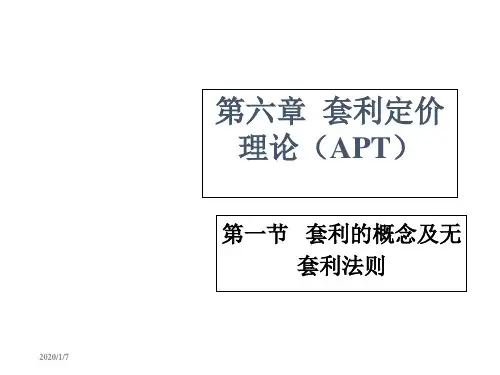
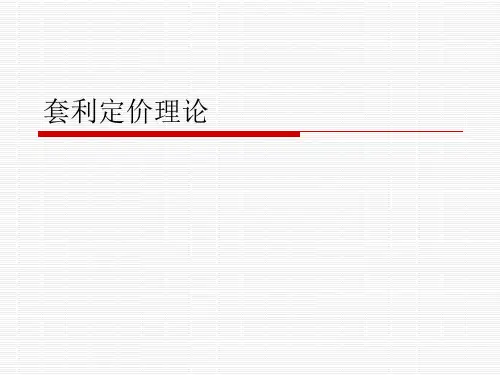
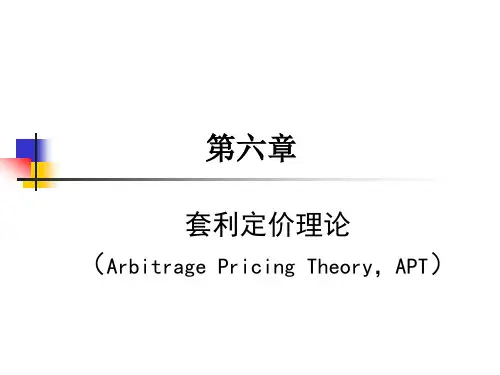
apt套利定价模型公式APT套利定价模型公式APT套利定价模型(Arbitrage Pricing Theory,简称APT)是一种用于评估资产定价的理论模型。
它基于一个假设,即资产的预期收益可以通过一系列因素的组合来解释和预测。
这些因素可以是宏观经济因素、行业特定因素或公司特定因素等。
APT套利定价模型的公式如下:Er = Rf + β1F1 + β2F2 + ... + βnFn + ε其中,Er表示资产的预期收益率;Rf表示无风险利率;β表示资产对各因素的敏感度或贝塔系数;F表示各因素的影响;ε表示不可解释的部分或误差项。
根据APT套利定价模型,资产的预期收益率可以通过对各因素的敏感度进行加权求和来确定。
这些因素可以是市场因子(如股票市场的整体表现)、经济因子(如通货膨胀率、利率水平等)或公司特定因子(如盈利能力、市场份额等)。
在使用APT套利定价模型时,首先需要确定适用于特定资产的相关因素,并计算出每个因素的贝塔系数。
然后,根据资产的预期收益率、无风险利率和各因素的敏感度,可以使用公式来计算资产的合理定价。
APT套利定价模型的优势在于它可以通过考虑多个因素来解释和预测资产的收益,相比于传统的CAPM模型,更具灵活性和适应性。
它可以更好地适应不同市场环境和资产特征,提供更准确的定价结果。
然而,APT套利定价模型也存在一些局限性。
首先,确定适用于特定资产的因素和计算贝塔系数是一个复杂的过程,需要充分的数据和分析。
其次,模型中的预期收益率、因子敏感度等参数的确定也存在一定的主观性和不确定性。
为了有效利用APT套利定价模型,投资者需要进行充分的研究和分析。
他们需要收集和整理相关数据,确定适用于特定资产的因素,并计算出各因素的贝塔系数。
然后,他们可以使用公式来计算资产的预期收益率,并与市场价格进行比较,以确定是否存在套利机会。
APT套利定价模型是一种用于评估资产定价的理论模型。
它通过考虑多个因素的影响来解释和预测资产的预期收益率。